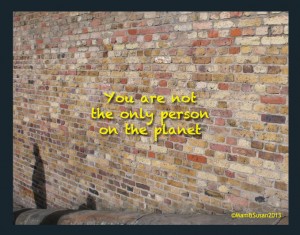In my home town of New York City, we are fierce about our First Amendment rights (and don’t ever get us started on the Third—affordable housing being what it is in this city, that forced quartering of troops thing really gets under our skin). Maybe I couldn’t get my word out on privately-owned mass media, but there was nothing stopping me from taking it directly to the People.
[mantra-pullquote align=”left|center|right” textalign=”left|center|right” width=”33%”]The revelation won’t be televised.[/mantra-pullquote]
What better way to do this but in the time-honored tradition of street-preaching in Times Square? After all, The Breast of Everything isn’t merely about a talking breast; it’s about a talking breast that starts a new religion!
On matinee day, I loaded an old messenger bag up with business cards, made sure I had my lawyer’s number on speed dial and headed for the subway. My first stop was the Toys R Us on Broadway. No point spending big money on a wireless mike—unless, of course, I’d find a tube of neon pastel plastic more embarrassing than the act of yelling the gospel according to Mam on the streets of New York. The WrapStar model seemed eminently practical, or at least harder to drop or have yanked away by an angry mob, and had a refreshing lack of sparkly bits.
When I was a kid, there was always a single revival-style preacher in Times Square, a skinny guy with a big voice, wearing a black suit so old that what wasn’t worn to grey was shiny as patent leather. Maybe there’d also be a couple of guys with sandwich boards, and sometimes Moondog would wander by from his usual spot in front of Black Rock. These days, since the area has become a pedestrian mall, there’s a lot more competition for curbspace.
Today, the area is a parking lot of footsore tourists, iced lattes and unlicensed cartoon characters. At 5’2, I disappear into this kind of crowd. I scrounged for a folding cafe chair that felt stable enough to stand on and, when I found one, I climbed up, flipped the on switch and let fly with my very favourite Mam-ism: You are not the only person in the Planet!
Too right. I was immediately drowned out by a pair of steel drums, a team of kids break-dancing for spare change, and an ambulance siren. I was also getting dirty looks from a small but determined group that had wandered up from Union Square with placards in support of the people of Turkey. Most discouragingly, the crowds around the TKTS booth were more interested in the opportunity to sit in a studio audience or grabbing discount passes to a comedy club than in paying attention to any of us.
It occurred to me that I was around the corner from the NY home of a religious movement that, not so many years ago, had been in a similar position to mine. They no longer have to give away free L. Ron Hubbard classics from a folding table in front of The Church of Scientology, but the precedent cheered me. Prudently far from their door, I chose to open with Mam’s words from the Beltane Confluence (Chapter 7): “Greetings to all who honor Nature!” Nobody stopped me, but no one heard me, either. It was a miscalculation on my part. It’s really hard to have a revival meeting without the crowd and West 46th is pretty quiet right now. The only thing playing is Motown the Musical, and either the toy mike wasn’t strong enough to read over the soundtrack bleeding out the doors or the people filing in just didn’t care.
So I went north a few more blocks to The Book of Mormon and waited for the desperate smokers to come running out during intermission. It wasn’t a big crowd. There aren’t as many smokers left as you might think, and no one else wanted to leave the nice air-conditioned theatre for the city sauna. The few who did come out were really getting into it. I thought I was making some headway, until I started handing out cards and they realized I wasn’t a member of the cast.
I finally gave up and headed home. It turns out that I don’t have what it takes to be a religious leader. That’s OK. I’m only a writer, after all. And it was certainly an interesting marketing idea.

